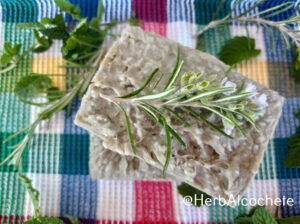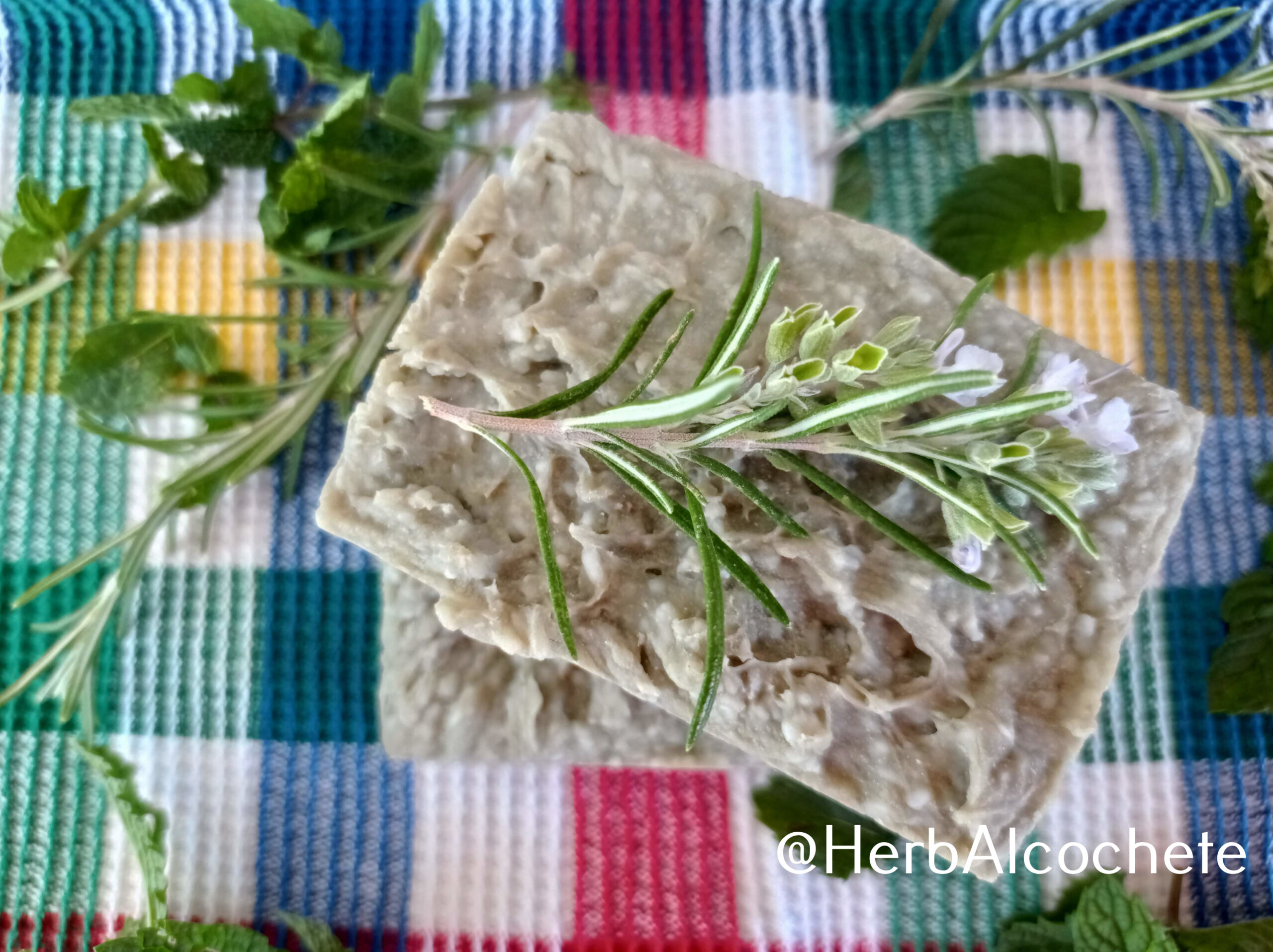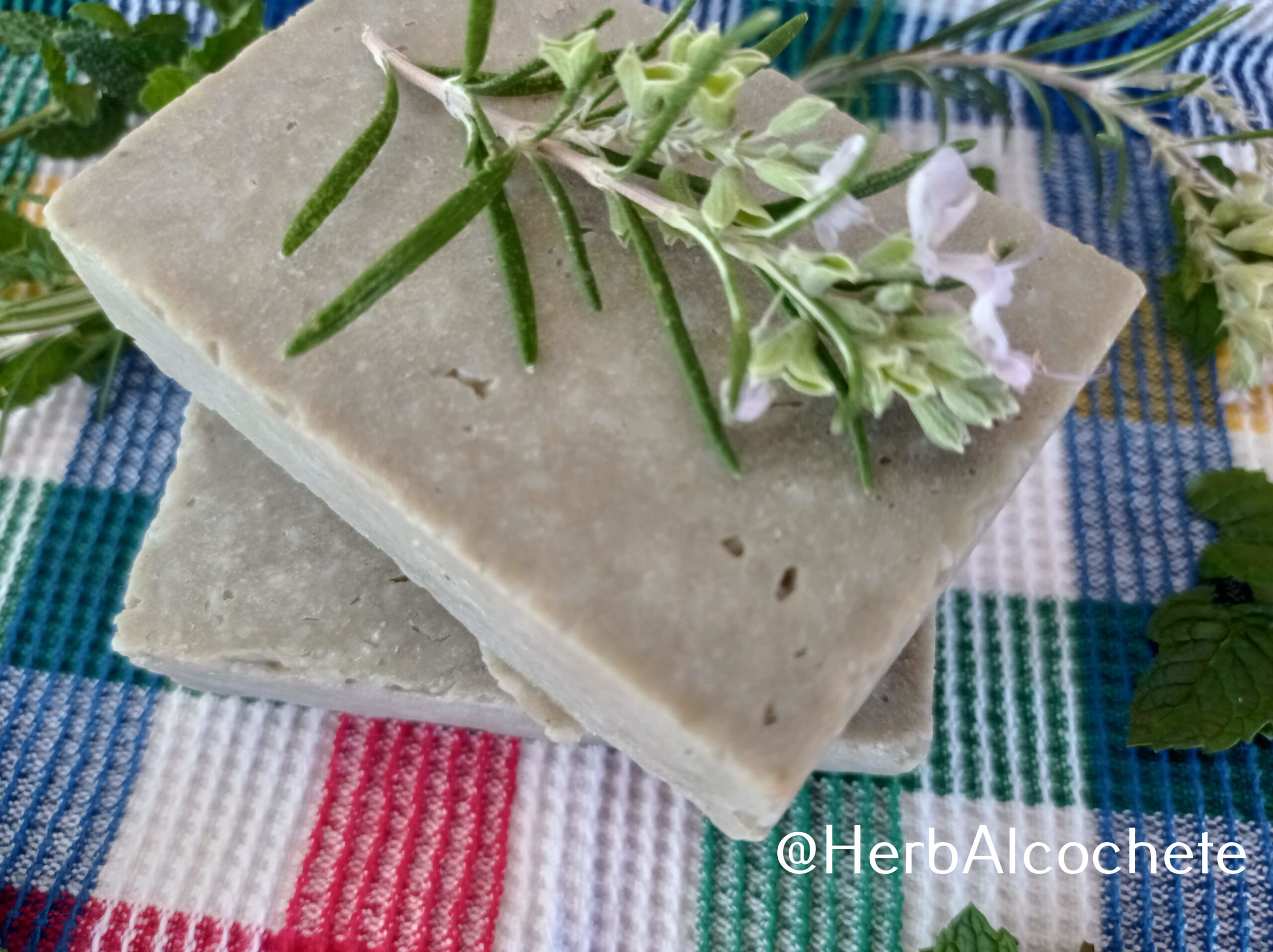In natural haircare, rosemary promotes hair growth and deeply conditions hair. It may also help with dandruff and keeping your scalp clean. A shampoo bar enriched with rosemary stimulates and cleans your scalp, closes hair folicles, and contributes to hair conditioning, keeping your hair healthy and shiny. Try this rosemary solid shampoo bar recipe at home.
Rosemary is a culinary and healing herb. This woody perennial is native to the Mediterranean region, where it’s been used as food and medicine for centuries. Being from Portugal, I know rosemary from delicious stews. Rosemary has been used in folk medicine to alleviate several diseases. During the last decades, researchers focused more on herbs in drug discovery because of their limited side effects and fewer complications.
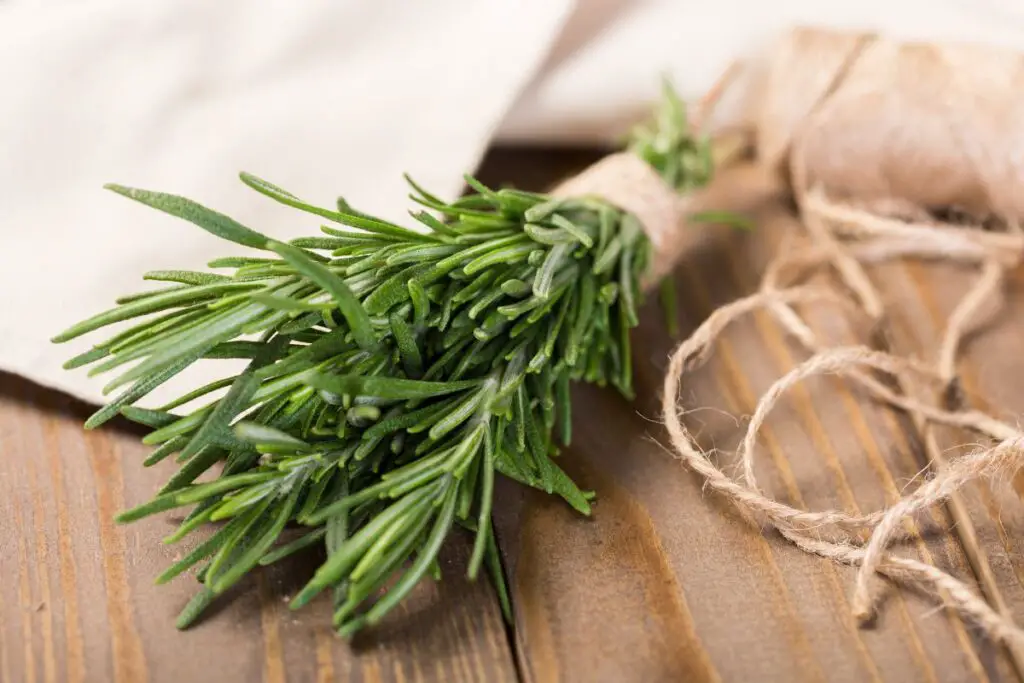
Table of Contents
- What Are The Benefits Of Rosemary For Hair?
- Does Rosemary Really Work For Hair Loss?
- How Do You Add Rosemary Leaves to Shampoo?
- What Are The Ingredients For Rosemary Shampoo Bar?
- Rosemary Solid Shampoo Bar with SCI
- Find Where to Buy Natural Shampoo Bars
- How Do You Use a Solid Shampoo Bar
- Related Posts
- Watch This Video Tutorial Before Starting Your Recipe
What Are The Benefits Of Rosemary For Hair?
The idea that rosemary oil encourages hair growth has been around for centuries. Mediterranean cultures use rosemary in hair rinses to promote hair growth for hundreds of years. But if you want, like me, more scientific evidence, the idea may come from the rosemary’s basic health benefits. The plant in essential oil form is said to:
- have anti-inflammatory properties
- promote nerve growth, due to carnosic acid
- improve circulation
Like peppermint essential oil (also used to promote hair growth), rosemary essential oil strengthens circulation. As a result, it could prevent hair follicles from being starved of blood supply, dying off, and leading to hair loss.
Beyond stimulating hair growth, and sclap circulation rosemary essential oil is used to prevent premature graying and dandruff. It may also help dry or itchy scalp. Check out the complete article in Healthline – Rosemary oil for hair.

Does Rosemary Really Work For Hair Loss?
Regarding hair loss in specific, scientific studies show rosemary capability to stimulate and improve hair growth with certain patologies, like androgenic alopecia.
Carnosic acid, an active ingredient in the plant, healed tissue and nerve damage in one study. This ability to heal nerve endings may rejuvenate nerves in the scalp too, in turn possibly restoring hair growth.
Take these conclusions carefully as there are very few clinical studies for humans. Still, folk medicin defends rosemary as very good for hair growth and hair conditioning.
I have a shrub in my backyard and I use rosemary in most of my haircare, for more than two years by now. I can’t truly say that it helps to grow my hair. But I can say it doesn’t hurt to use it.
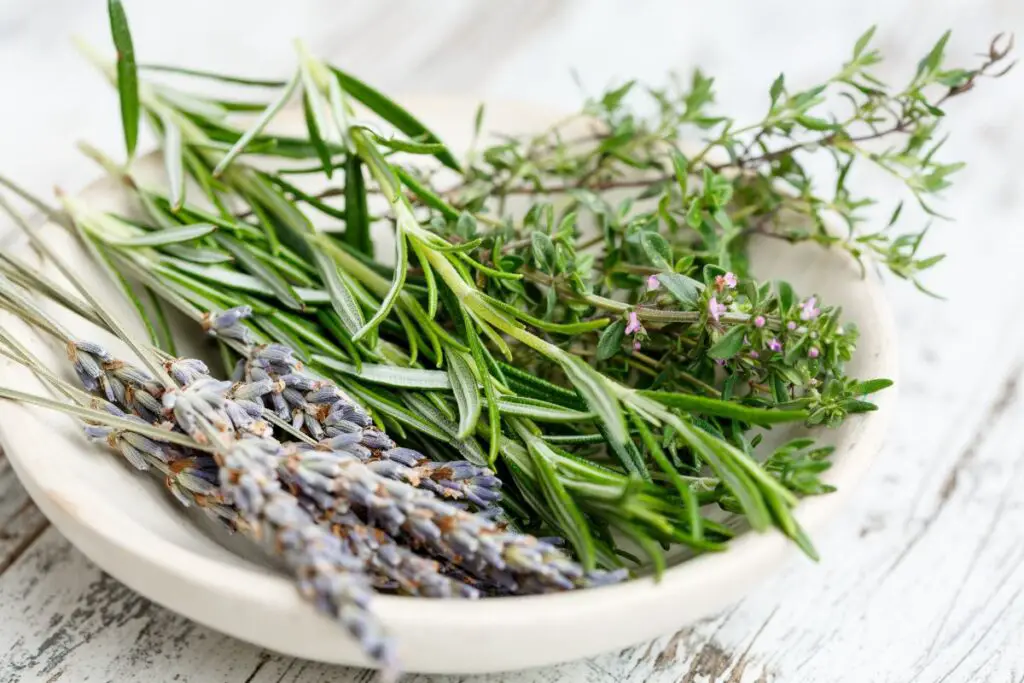
How Do You Add Rosemary Leaves to Shampoo?
This rosemary solid shampoo bar recipe uses rosemary leaves in the form of infusions: rosemary-infused water and rosemary-infused oil. Both are optional and you can make your shampoo with plain distilled water or plain oil. But you wouldn’t be benefitting from rosemary wonderful properties.
You can add rosemary leaves infused in oil in any hair care product, even as an oil itself, as a hair mask or a pre-wash conditioning treatment. Infused water is trickier as you need to add a preservative, pretty much like in this shampoo bar.
To make rosemary-infused oil, use 20g of argan oil and enough leaves to fill in 2/3 of the oil. Check out also the article How to Make Infused Oil With Dried Herbs. To make rosemary-infused water, fill in a cup with leaves and cover it with boiled water. It’s like a tea, or correctly said, like an herbal infusion to drink, but stronger.

What Are The Ingredients For Rosemary Shampoo Bar?
This recipe uses 2 surfactants, SCI and cocamidopropyl betaine. They are synthetic ingredients. But, as explained in Solid Shampoo Bar Recipe With SCI they are among the mildest surfactants, very often used in baby shampoos. They allow to respect the pH your hair and scalp, and cleanse them from oils and dirt without being too agressive.
Why am I using 2 surfactants? Well, you can use SCI only, no problem, but cocamidopropyl betaine, as an amphoteric surfactant, helps lower the surface tension of water so that soap can permeate the water more efficiently for cleaning. Ok, in other words, soap and water glides better down your hair and carries more dirt and oils, compared to only SCI and hard water. It also turns the shampoo bar milder.
Besides rosemary-infused water and rosemary-infused argan oil, this rosemary solid shampoo bar contains a small amount of green clay for color and added cleansing properties, and a healthy amount of rosemary essential oil. Peppermint essential oil adds to the hair growth properties and a wonderful minty scent.

Rosemary Solid Shampoo Bar with SCI
This shampoo bar is deeply enriched with rosemary so that your hair strands and scalp can take the most benefit of rosemary properties when you wash it. However, you can adapt the recipe, whether you want to make it cheaper, richer or you are lacking some of the ingredients.
You can skip cocamidopropyl betaine. Adjust the quantity of SCI to 55% and add distilled water for the other 5%. You can use rosemary hydrosol instead of rosemary-infused water. Or just use distilled water.
Argan oil is a very light oil used for haircare, but it’s expensive. Alternatives are jojoba oil or coconut oil.
Still, give it a try at this recipe. Enjoy making your shampoo bars at home!!
Find Where to Buy Natural Shampoo Bars
Willing to try or use regularly natural shampoo, but you’re not really into DIY? Want to go zero-waste crazy with shampoo bars? Find where to buy natural haircare shampoo bars, listed by main ingredients and hair type:
- Rosemary and Mint Shampoo Bar (Etsy)
- Aloe Vera Shampoo Bar – for dry hair and sensitive scalp (Etsy)
- Jojoba Oil And Nettle Shampoo Bar for Volume and Shine (Etsy)
- Calendula and Chamomile Shampoo Bar for Itchy Scalp (Etsy)
- Oat Solid Shampoo Bar For Sensitive Scalp (Etsy)
If you love shampoo bars and have no issues in using them, find some at the following links:
- Apple Valley Shampoo Soap Bars (don’t forget the Hair Rinses)
Here’s a choice of natural liquid shampoos if you prefer the liquid stuff:
- Dry Hair Shampoo (Just Nutritive)
- Oily Hair Shampoo (Just Nutritive)
- Grow New Hair Shampoo (Just Nutritive)
- Restorative Shampoo For Dry Hair (100% Pure)
- Pure Glossing Shampoo (100% Pure)100% Pure Glossing Shampoo
How Do You Use a Solid Shampoo Bar
Wash your hands and wet your hair in the shower or bath. Make a lather first with the shampoo bar, water and your own hands, then spread the lather in your hair.
Once the shampoo bar is making a lot of foam, you can also apply the bar directly on your hair. Make sure you follow the direction of your strands to avoid knotting or tangling your hair. Apply mostly in your scalp, avoid the ends. Massage your scalp with your fingertips for a few minutes. Avoid using your nails at all costs. Rinse and repeat until you feel your hair and scalp well washed.
The shampoo bar might not create a lot of lather the first time it’s used – I have no idea why, but it’s something I have observed. Be patient and create a lather with your hands for a little longer. The shampoo bar should create as much foam as a liquid shampoo. If not, probably your scalp just needs another wash.
A neat trick is to use your shampoo bar in the shower inside a saver bag. It helps create more lather.
Related Posts
- Vegetable Oils: Natural Oils For Skin
- Essential Oils: Essential Oils For Haircare Recipes
- Syndet Bar Tutorial: How Do You Make a Syndet Bar?
- Shampoo Bar Recipes: Haircare Recipes
Watch This Video Tutorial Before Starting Your Recipe
Equipment
Ingredients
Solid Phase
- 55 g SCI (sodium cocoyl isethionate)
- 0.5 tsp french green clay (optional)
Liquid Phase
- 25 g rosemary-infused water rosemary-infused water
- 15 g argan oil rosemary-infused argan oil or jojoba oil
Cooling Phase
- 1,5 ml essential oil rosemary
- 0,5 ml essential oil peppermint (optional)
- 0,5 g Liquid Germall Plus check quantities as per manufacturer instructions
Instructions
Preparations and Good Practices
- Learn how to make a syndet bar in How Do You Make a Syndet Bar? or watch the video above. They don't have a recipe but explain in general the steps and ingredients to produce a syndet bar.
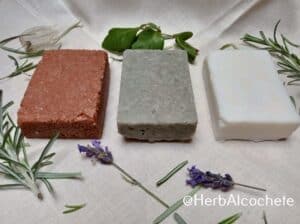
- Disinfect all your equipment before starting. You can boil some of your equipment (like the double boiler, glass cups, spoons), and use a solution of 1 liter of water with 1/2 cup of bleach, for items that are not heat-resistant (like the milk frother, plastic cups or the lotion containers)

- Check out the post What Is a Syndet Bar or the tutorial videos above. They don't have a recipe but explain in general the steps and ingredients to produce a syndet bar.
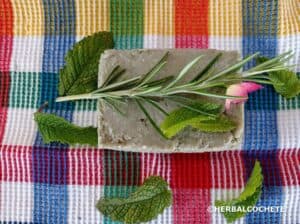
- Measure all ingredients and prepare your workstation. Wear a mask as the SCI releases an irritant dust cloud
- Make the rosemary-infused water in advance. Use 2/3 of a cup of rosemary with 1 cup of water.
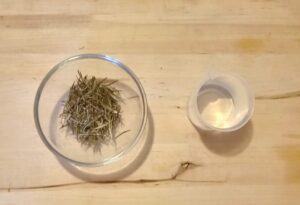
- Make the rosemary-infused oil with jojoba oil or coconut oil in advance. Learn how to make infused oil in How to Make Infused Oil
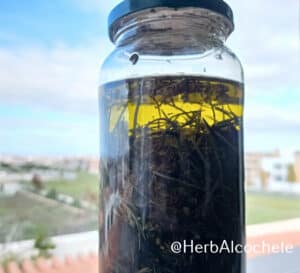
Liquid Phase
- Put a pan with water into the stove (any water as this is for bagne-marie)
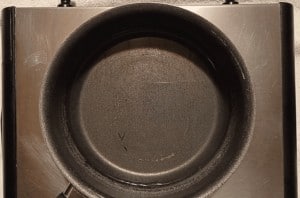
- Add the liquid ingredients into the double boiler or a metal jug. Let it heat in low heat, up to 50ºC.
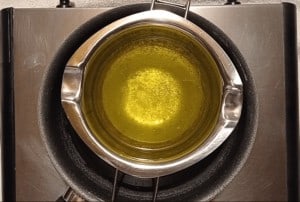
Solid Phase
- Add the solid phase ingredients (SCI with clay) and mix well with a spoon. I prefer to use a fork as it works as half spoon, half whisker. Preferably, add SCI 1/3 at a time, and mix gently but thoroughly before pouring more. Let it melt and incorporate well in the mixture.
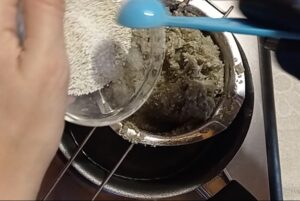
- Mix and heat the mixture in low heat until it has the consistency of homogeneous mush or porridge.
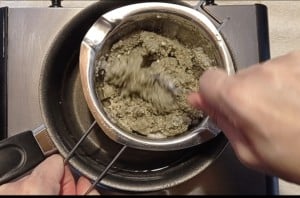
- Remove the double boiler or jug from heat. Mix a bit to cool down the mixture.
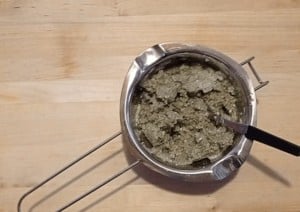
Make Your Bars
- At around 50ºC or lower, add the cooling phase ingredients: essential oils and the preservative. Mix well.
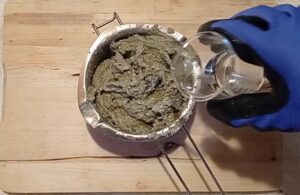
- Take 1/4 tsp of the mixture and dilute it in 1 tsp of warm water. Dissolve it well and use a pH strap to measure pH. Should be 5-6.

- If pH is too high add a bit of lemon juice or citric acid, or baking soda if it's too low. Mix very well and measure the pH again.
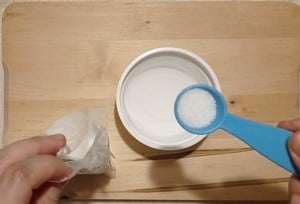
- Pour the mixture into a soap mold. Let it harden completely (24 hours). After unmolding let it dry for 2 or 3 days.
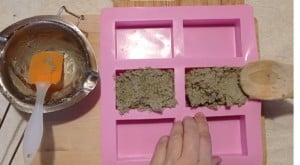
- Your shampoo bar is ready to use!
